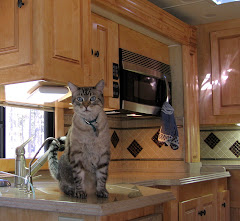Coming attractions
September 17th takes us into Bowling Green KY for a tour of the Corvette Assembly Plant and across the highway, the National Corvette Museum.
The factory tour begins at 11:00 AM and no cameras, cell phones, or purses – back packs etc. are allowed. Thus – no pictures! We strongly recommend you watch the factory tour as presented by the National Geographic channel. It is an outstanding production and you will see far more than we did with a small tour of 24 people. Normally they take 80 people at a time!
After the tour, we drive directly to the museum. The facility rests right alongside the freeway and sports a tall yellow “hat” with a red cone attached to attract attention. After parking, as we walk to the front door, we notice hundreds of engraved concrete bricks, several with names. Apparently these are to honor both business and individuals who have made contributions to this private charitable foundation.
Inside the museum, one of the first things we learn is where the name comes from. Both the Canadians and British rigorously defended the shipping lanes in the North Atlantic Ocean. These new anti-submarine ships were called Corvettes, French for “fast sloop.” Ten years later, Chevrolet decided to name their new fast sports car after these ships. The slide show at the end shows a picture.
Originally, the logo contained the checked flag and the American flag. Hours before the introduction of the car, someone remembered that the American flag cannot be used for commercial purposes. Since the car had a French name, the French fleur-de-lis was selected at literally the eleventh hour.
There are several period displays featuring the Corvette. More can be seen in the slide show.
Of special interest is the World’s only Three’s Display; along one wall, displayed were the original 1953 model, followed by 1963, 1973, 1983 (only car in existence) 1993, and finally 2003.
Each sign tells the story of the car. Double click signs and pictures for the full screen versions. Use your browsers' back arrow to return to blog.
At the end of this display, is the Corvette nursery. This area is reserved for persons ordering their Corvettes and electing factory pick-up. Pretty snazzy cars these Corvettes. I should add that Bob was absolutely drooling. Concurrently, I had this feeling of relief that with a little luck, I will never have to buy a vehicle again. I’m very happy with what we have!
Museum interior
The “hat” section of the building contains specialty cars; cars with special colors that never made production, and some of the Indy 500 Pace Cars, and or replicas of Pace Cars. This is a fun and very colorful section of the museum to visit.
At the end of course, is the required gift shop filled with everything Corvette. We managed to escape with two gift T-shirts. I told Bob he could forget about buying one. His sports car is our Honda del sol.
Try this slide show. You'll like it!
Coming next: Join us for lunch in historic downtown Bowling Green!








































































